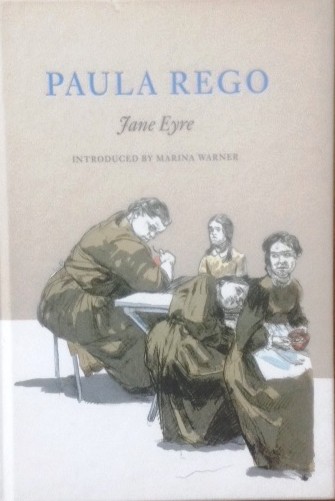Inspiring Older Readers
 posted on 10 Apr 2022
posted on 10 Apr 2022
Jane Eyre by Paula Rego
In her introduction to this Enitharmon Edition of Portuguese-British artist Paula Rego’s illustrations for Charlotte Bronte’s Jane Eyre, critic Marina Warner tells us that Rego has had a longstanding fascination with the novel. And anyone who has any familiarity with Paula Rego’s work would hardly be surprised – the two share an obvious Gothic sensibility that Warner also highlights:
“Brontë and Paula Rego share an imaginative ardour that abolishes the veil between what takes place in fact and in fantasy. As storytellers, they really are kith and kin: Rego reproduces the psychological drama in the book through distortions of scale, cruel expressiveness of gesture, and disturbingly stark contrasts of light and welling shadows. The long, lugubrious, moralising face of Mr. Brocklehurst in The Inspection looms as large as the little girl’s whole upper body and twice its bulk: Jane standing on the stool, held by Bessie, becomes a tiny, breakable poppet.”
The format of the book showcases Rego’s interpretation of Bronte’s prose through the use of twenty-five of the artists lithographs along with excerpts from the novel. Each of the drawings is given its own full page and the exquisitely heavy grade art paper makes this whole volume a desirable artefact in its own right.
What typifies Rego’s art is her refusal to look away even at the moments of most intimacy or degradation and this makes the domestic horror of Jane Eyre leap out at the reader. Warner argues that she achieves this by a sort of empathetic embodiment of the character of Jane:
“Rego’s responses to a classic tale of mythical aura, like Jane Eyre, translate the novel’s character into another medium, reproducing its mood and its texture in kinetic line and moulding shadows. The benightedness of Jane’s state finds its correlative in the inkiness from which she materialises before our eyes; the dynamic nature of her resistance to her fate leaps in the vitality of her contours, and so forth: the visual technique matches narrative wordplay in reciprocal counterpoint.”
It’s an interesting interpretation but while this notion of identification and empathetic embodiment clearly has a good dollop of truth about it, I think there is a danger that it underplays Rego’s own powerful persona and world view that she is overlaying on the fiction.
Laurent Bury in her study of Rego’s lithographs, Creative (mis)reading? Paula Rego’s Jane Eyre argues that the artist deliberately misrepresents Bronte’s intensions and that this misdirection speaks more about Rego’s vision than Bronte’s. However, she concludes that:
“What should be especially admired in Rego’s creative (mis)reading of the novel is that, with less than thirty pictures, she has managed to offer a truly original and enriching vision of Brontë’s work….”
Unfortunately, this 2004 Enitharmon edition that I’ve been admiring doesn’t come cheap – some copies advertised on the internet seem to be nudging three figures. I would advise you to keep your eyes open for a bargain in a charity bookshop or maybe consider a visit to your local library and see if they can get hold of a copy for you.
STOP PRESS
In between writing this review and publishing it today, I’m delighted to say that the publisher, Enitharmon, has decided to reprint this book in an extended version. Their press release says:
“Since its first publication in this format in 2004, Paula Rego’s Jane Eyre has been a firm favourite with art lovers and readers devoted to Charlotte Brontë’s celebrated novel who have relished Rego’s deeply imaginative responses to salient incidents in the story. Now redesigned and extended, Rego’s Jane Eyre impresses all over again with its highly dramatic lithographs and carefully chosen texts, tracing Jane’s progress from the shy bookish girl studying Bewick’s History of British Birds and dreaming of the Arctic seas to the confident young woman who survives the dramas at Thornfield Hall and captures the heart of Mr Rochester. Throughout, Rego’s beautiful images illuminate the narrative, whether in monochromatic drawings or full-colour scenes such as that in the fold-out triptych Getting Ready for the Ball. In a magnificently acute and wide-ranging introduction, Marina Warner places Paula Rego’s achievement in the context of some of the great artists and illustrators of the past, from Gentileschi and Goya through to Gustave Doré and Théophile Steinlen, while at the same time establishing Rego’s place as a supreme storyteller who brings her typically acute psychological understanding and masterly draughtsmanship to this brilliant reimagining of a much-loved classic.”
The book can be ordered directly from the publisher for £25 on https://enitharmon.co.uk/product/jane-eyre-paula-rego-charlotte-bronte/?mc_cid=82777bccf8&mc_eid=ed15a460a0
Terry Potter
April 2022




